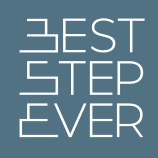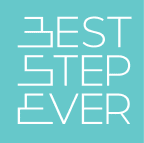Speed up the agility and growth of your employees through continual learning. Do this by building powerful learning pathways using these five easy steps.
Wow, learning and development has undergone a lot of change over the past few years. Remember when we called it training and we structured it as a single event? It didn’t happen frequently. And it was mostly for the elite few.
Nowadays we expect all employees to be agile. And to grow and learn as they work. Continuously.
Agility gives us the power to respond and realise the full potential of each situation. But agility is a learnt skill for most. Companies who design smart learning paths for their employees help to build this agility and resilience.
And that’s when agility becomes a metacognitive process.
A what?
Simply put, we become aware of our own thinking processes and how to use those to best effect when we learn. So, if we want to become more agile, we become aware of the circumstances under which we are best able to learn to be more agile.
Why is this important? Well, this self-knowledge helps us to become a whole lot more effective, a whole lot faster.
What is learning agility?
It’s a complex mix of an individual's willingness, ability to learn quickly and the skill of rapidly incorporating the newly discovered knowledge into their changing environment. Being agile allows us to take new theory and knowledge, practice what we’ve learnt, and apply it in different contexts. People learn from being able to reflect on their experiences.
So, is learning agility a learnt skill or an inherent ability?
There is much merit in saying that individual learning agility is an inherent ability. We are all born with the ability to learn.
Yet, it’s also a learnt skill.
When we nurture this inherent ability, we can boost its effectiveness.
It is, thus, a primarily nurtured ability and skill that requires practice by people to learn, apply, reflect, unlearn, and relearn. And adapt and use these past experiences in a future situation.
And in the workplace, it works best when it’s anchored to a specific job role and clear outputs.
So, what are the behaviours of a highly agile employees?
Research indicates that agile people have the following behaviours:
- •They are innovative and creative in developing new plans and ideas quickly.
- •They are willing to challenge others and express their own opinions.
- •They are performance orientated, focused on picking up new skills and adapting rapidly to new situations.
- •They are reflective, have high self-awareness and are insightful about themselves.
- •They are good at how they deal with various problems and are good at managing change and challenges.
- •They are risk pioneers, tending to seek out learning experiences and allow new learning to occur.
- •They are significantly calmer in new and challenging situations that may serve as new learning experiences.
Employers highly value agile and resilient employees – in fact it’s a top skill that’s greatly sought after.
Why is this so important, you ask?
Every year the pace of change accelerates. Disruptive ideas and technologies emerge more and more frequently, and they start to shape our work and our life.
People with high learning agility find it much easier to adapt to these frequent changes.
Here's what agile employees offer their employers:
| Flexibility | They’re not rigid or set in their ideas. They can easily change direction to deal with the latest business challenges. |
| Willingness: | They are willing, innovative, and ready to face the challenges of uncertainty. They assist in boosting the organization's innovation and creativity. |
| Foresight: | Agile people can predict changes in how they need to work and adapt to the new changes. And thus, continue to grow faster than their peers. This ability to change enhances their productivity. |
| Adaptation: | They reflect and learn from past and recent experiences. From this they see new directions and alternative ways of doing things. They may seek out the latest knowledge before the situation changes. |
But is it only the individual responsibility to perform these actions?
Surely learning and development (L&D) teams have a major role to play in building this ongoing learning agility?
Are these L&D teams providing clear and mapped out learning pathways to employees? Which enables these employees to discover and learn new knowledge?
Defined learning pathways are the ways to provide for this need.
Learning events versus the learning pathway
All learning is important! And in different contexts, there are many ways that this can take place.
A learning event is a single, often pre-planned (although not always) and protected learning opportunity that allows people to discover new knowledge. It can happen anywhere and at any time, for example, in academics or the workplace.
So how is the learning pathway different from a learning event? Well, it is not that different. A learning pathway in its simplest form is a curated and defined set of sequenced learning events that end in an agreed goal.
So, it’s a bunch of learning events which are linked together in a coherent way to create a clear pathway from A to B.
A learning pathway could also be the route the organizational learning planner takes through various learning events or activities, including milestones, allowing the learner to build knowledge and reach a final destination.
Why is this even important?
Well, it gives us a clear set of stepping-stones to navigate how we acquire specific knowledge.
For the organization, learning pathways offer the L&D department an opportunity to steer the learner in a way that meets the organization's objectives. At the same time, it provides opportunities to meet personal goals. This is also known as learning pathways methodology.
- For example:
An organization needs a new employee to be orientated in the workplace. They offer a series of induction and orientation learning events which link together into clear learning goals. The overall learning pathway covers everything the employee needs to know, including a lot of organizational contexts. There’s a specific component on how the company is using new technologies and its benefits in relation to the employee’s job and how they can benefit from this.
Organizationally, learning pathway methodology makes much sense as it defines a clear and logical learning path for employee training.
The organization creates a learning pathway for the employee's entire function and then seeks to train them along it.
Doing so looks at the learning requirement as a complete process rather than a single event. It enables the organization to find new ways to vary the training and drive out time-wasting events. This leads to reduced costs, improved results, and effective return on investment of the money being spent.
Learning pathways have been proven to reduce time to proficiency by 30 to 50%.
Advantages of using a learning pathway
At their best, learning pathways pull together different resources into a rich and coherent learning journey. At their worst, they add “noise” to an already overcrowded and disordered buffet of corporate learning.
Here are some of the more obvious benefits of a well-designed learning pathway:
*Creates satisfaction as learners move past each learning event. People like to see a path towards progression.
*Empowers individuals to acquire and apply knowledge in a logical manner.
*Reduce time-waste by providing a clear and sequential process to build skills and competencies.
*Provides a coherent structure for staff development which is clear and understandable.
*Creates ownership of the learning journey as a continuous process.
*Allows L&D teams to align knowledge towards strategic outcomes.
*Enhances knowledge retention if the path is iterative in nature.
*Enables holistic and integrated approach to skills acquisition
5 steps to build powerful and future-ready learning pathways
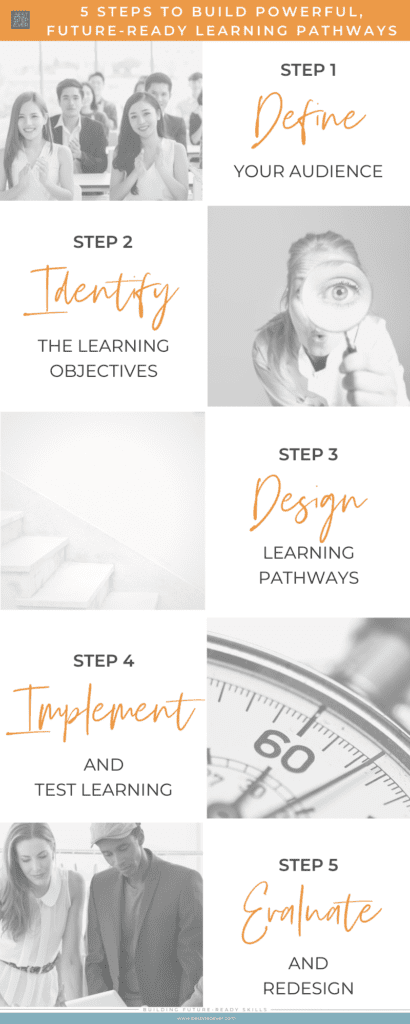
Ok, so we’re convinced. We need to put more work into building learning pathways that stimulate and guide the learner to acquire skills. And to make it easy for ongoing learning and growth to take place, whilst at the same time building agility and pro-activity.
Here’s a simple way to get started:
Step 1: Define the audience
At this stage you consider who the learner is. What prior knowledge and skills do they have? What are their expectations?
What learning styles do you need to accommodate? How can you make the learning pathway interesting and meet diverse learning needs?
And lastly, how you are you going to make it interesting for the learner? How will learning relevance be communicated? We’re all more motivated to learn when we have a clear understanding of WIFM – what’s in it for me? Why will this pathway be useful to them? It needs to be made clear from the start so that the learner’s motivation can be activated.
Step 2: Identify the learning objectives
This is the part where L&D plans and sets the stage for the upcoming learning.
This is likely to include identifying skills gaps, defining the learning objectives, mapping the course, and designing or sourcing the content. The L&D team needs to consider the wider context of strategic and organizational needs within which the learning path takes place.
Examining the course content and content sequencing is also essential to this stage. For example, communication skills need a certain level of knowledge about the language. If these are not present, the learner may need to first engage in a communication skills development pathway.
This step also includes:
| Defining the start and end points, the learning goal, and the learning outcomes. |
| Assessing what is available and what can be used, including setting out the pathway deliverables (events and/or milestones) - much like an architect does a detailed drawing of a building. |
| Understanding the differing learning needs and styles of the learning audience and the motivational factors required. |
| Seeking out assessment or evaluation of the newly acquired knowledge in an experiential setting. |
There are also practical considerations. For example, how will learner notification work, how will progress be recorded etc.
How will the learning be housed? In a learner management system, learning experience platform or other?
Incorporating and acknowledging the learner’s prior knowledge is also vital during this step. The learning pathway architecture may provide a review and pre-work to engage this.
During this pre-learning stage, the pathway must include the development of the learner's agility. They may not be free to design their journey. Rather it’s about supporting how they will act and behave within the learning events. And afford them guided opportunities to apply their knowledge to different situations.
- Consider this example:
Your L & D team has proposed that great leaders are trained and that it is a learnt skill. They have defined several learning objectives and milestones that will assist in determining the pathway of becoming a learning leader. One of these might be.
»Leading with emotional intelligence; relationships and motivation management«
This topic encompasses a lot. At a minimum, the three learning event requirements are a) emotional intelligence, b) relationship management, and c) motivation management.
Thus, each of these learning events may very well define a separate learning pathway for the individual, as each is a large and often a complex subject.
Step 3: Design learning pathways
So far, so good. Now for the really hard part.
This is where L&D has to get down to the actual design. The mini objectives and milestones along the way have to be clearly defined.
And then these aspects have to be considered:
- What’s the mode of delivery and by whom? Online, offline, real time, facilitated, 24/7 or set times, etc.
- How will it be made interesting and versatile to enhance the learner experience?
- Is content going to be created or curated? What exists already in the organization that can usefully be incorporated? What needs to be added?
- How will you create learning scaffolds? We learn new things best when we fit it into a scaffold of things we already know. How can we integrate these new things into existing knowledge?
- How will you keep learners motivated? By incremental awards, gamification, other forms of acknowledgement?
And very importantly how will knowledge cognition be developed?
These include:
| Factual knowledge | I.e. basic information about the subject. This information can be gained through exposure, repetition, and commitment to memory. |
|---|---|
| Conceptual knowledge | Knowing the interrelationships and functions among the details and elements that make up a larger structure. For example: Taking the example of a salesperson, knowing each product and its factual information is not good enough. They must also understand and compare each conceptually to provide the best advice to a customer. |
| Procedural knowledge | Subject-specific skills and methods along with criteria for deciding when to apply procedures. For example: An insurance agent who provides superficial advice by skipping questions and therefore does not follow standard procedure, putting the client at risk. |
| Metacognitive knowledge | Allows us to organize and evaluate our thought processes related to learning and problem solving. We could also call it *thinking about thinking, as it were. So, it’s about reflecting on and regulating how we think. For example: A manager is disappointed at the outcome of a meeting. She asks herself how she could do better next time. She questions whether she said the right things and what she could do differently to get a different result the next time round. |
Step 4: Implement and test the application of learning
This post-learning step covers the point at which a learner completes their formal learning to the point at which they apply it. It usually involves evaluating and applying the learnt knowledge outside the learning event.
These may include:
| Retention exercises, self-tests, assessments, case studies. They'll focus on the elements of recall and application. |
| Reflective exercises. Agility in thinking is characterized by where the learner thinks about what they have learnt and how they could apply it to other situations. |
| A post-course evaluation allows learner feedback to L&D for action. |
- For example:
The learner finishes an e-learning course. An online accreditation shareable on their LinkedIn profile or via work email is also provided.
Over the next five days, the learner is drip-fed summary content via email to promote knowledge retention and is nudged towards preparing for the final assessment.
The learner completes a post-assessment quiz online or via email, and the learner applies knowledge in the field within ten days.
See here for more ideas about how to assess employee skills development.
Step 5: Evaluate and re-design
This is the part where we close the circle.
We need to ask ourselves:
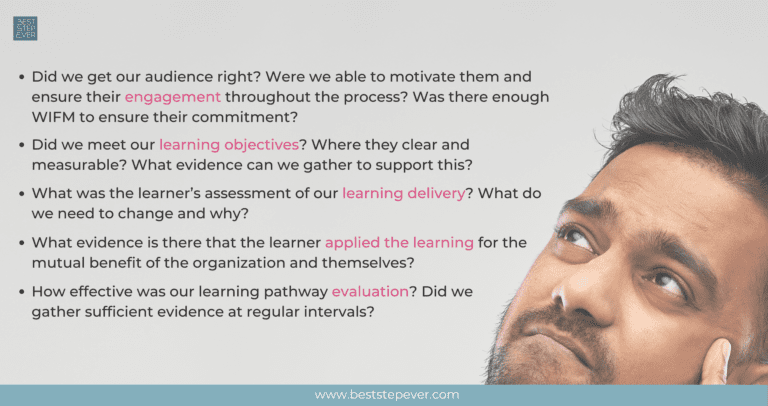
And then it’s back to the drawing board to create a stronger experience the next time round.
Trouble-shooting your learning pathway
Designing and implementing a learning pathway is hard. That’s why it can go wrong on so many levels.
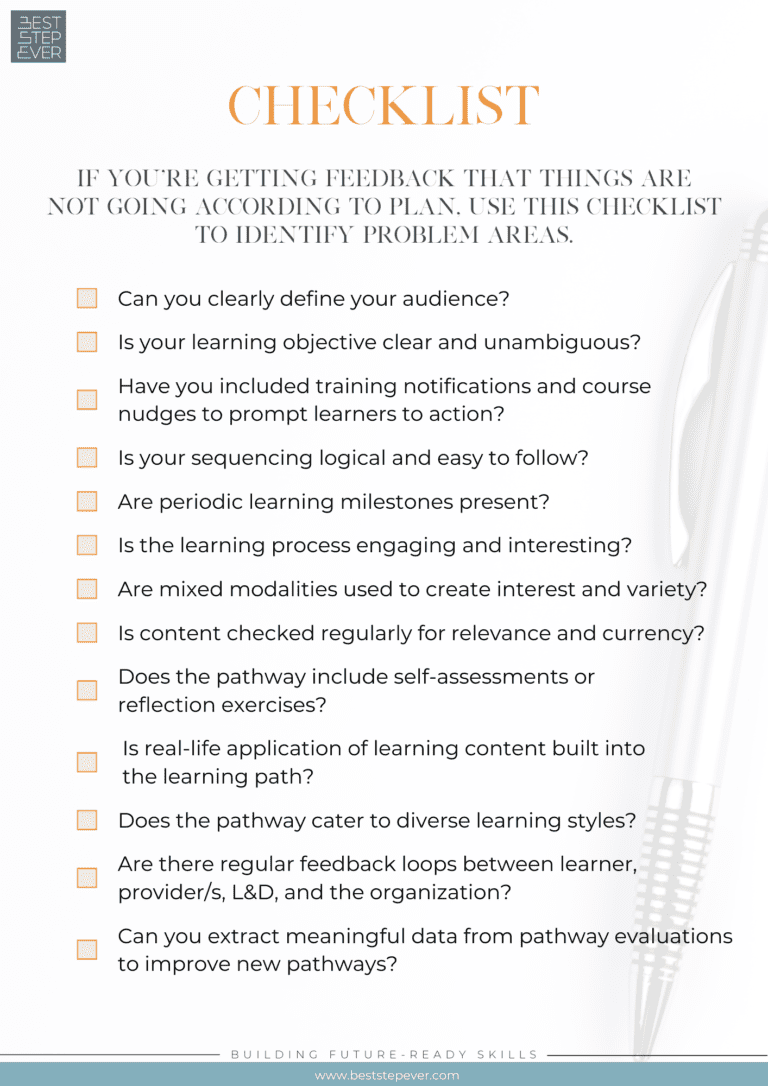
In closing
Learning pathways create meaningful ways of attaining and applying knowledge. The more effort that goes into creating a powerful learning path, the better the results. And at a metacognitive level, the organization can build agile and proactive employees who take charge of their own learning agenda.
If you’re still focusing on learning events rather than learning pathways, now’s the time to try doing it differently to get deeper results.
